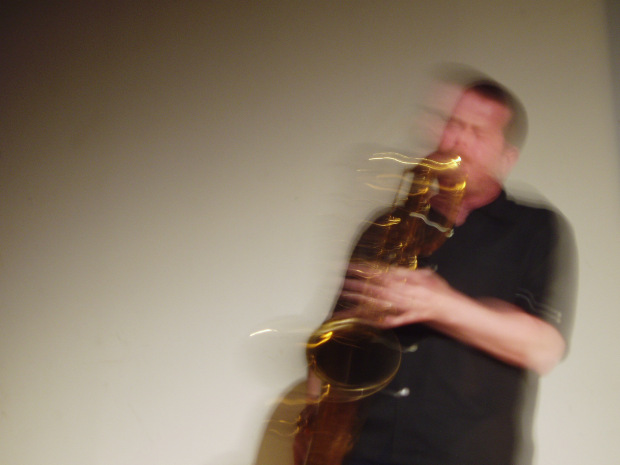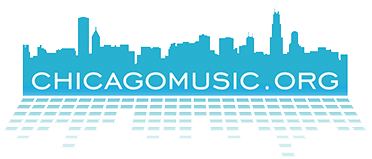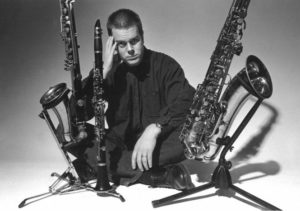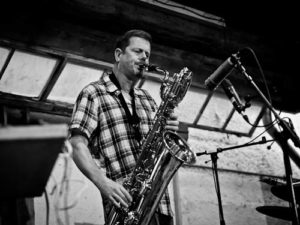Ken Vandermark: Six Dispatches From The Memory Bank

30 Aug 2012
By John Corbett
1.
Ken Vandermark/Paal Nilssen-Love
The Hideout, Chicago
2012
Most recent sighting.
Ken Vandermark, playing super relaxed horn, teamed with Paal Nilssen-Love, the Norwegian whose father was a drummer before him. If blood is carried to and from the bodily extremities by means of a steady pulse, the Nilssen-Love bloodline bears that beat along with more erratic rhythms: swing time, pushy punctuation, scraped plinging eruption, continuous clanging crescendo, a crash-and-tumble capability to rival Fibber McGhee. Having heard this twosome since they started playing together over a decade ago, I’m delighted this night to find them pushing into things unfamiliar, two set-length pieces plotted like a road trip: long stretches settle in, moving fast, the straightaways, then various side-trips, maybe to gas up or grab some grub, pleasant surprises off the main drag, stops and starts, change in speed, dynamic, scenery.
Vandermark has worked with some of the best percussionists in creative music. Long partnerships with Hamid Drake, Paul Lytton, Paul Lovens, Michael Zerang, Tim Daisy – these have all had their own special character, each an intensive dialogue, whether in the context of a group or one-on-one. The relationship to drums is crucial in Vandermark’s case; he’s a very direct saxophonist, prefers that to more oblique rhythmic interactions (though he’s capable of floating over the beat and more disjunct counterpoint, when called for), and that means the drummer is paramount. Whenever I hear Booker Ervin, I’m reminded of how important this bond is for players who dig in and plant themselves on or around a beat, and in the frame of time-based playing, that is how I hear Ken.
Playing with Nilssen-Love, Vandermark can move into the patterned, riffing repetitions that typify this part of his work, setting up something steady for the drummer to jostle against, creating tension, building expectation, and finally releasing. But he can also move into energy – with these two there is always plenty of energy – and pure sound, as he does when he lips the clarinet, puffing burbling little tones into the stream of Paal’s cymbals. In Nilssen-Love, I hear someone capable of pulling together all manner of disparate threads, drawing without prejudice from any possible musical arena. Garage rock, Latin soul, R&B, Ethiopian, these are more recent integrations; Paal has absorbed so much about bop, hard-bop, free jazz and improvised music that they’re but strands of DNA wound around the core of his concept. This makes him perhaps the perfect counterpart for Ken, whose working process has been to incorporate and synthesize the music he loves. You wouldn’t know it to see him, but that’s because Vandermark is a nerd. He studies day and night. At a party, wildly rowdy and full of whatever spirits have prevailed, he’ll stop dead at hearing something that catches his ear, take out a notebook and jot it down for later investigation. What I said: a nerd.
2.
Lombard Street Trio
The Willow Jazz Club, Boston
1987
I first heard Vandermark by accident. A few blocks from my apartment in Somerville, Massachussetts, was a little club I’d never visited, really seemed like an old-man bar to me, but walking past it one evening I heard something that sounded like live music, so I ducked in for a look. The Lombard Street Trio – guitar, drums, reeds – was winding its way through a sectional tune, mid-set, so I found a stool and a beer, together with the three or four folks who were already there, puzzling at the serendipity. It struck me that they were very obviously enamored with Dolphy, that I wasn’t so into the guitarist’s sound, that the drummer had a sweet feel, and that the saxophonist was pretty good.
Boston was a great place for creative music in the ‘80s. Before moving there, I had driven to Cambridge three or four times a week from Providence, where I was in school. Boston was, in some ways, where I got the better part of my education, and many late nights were spent at Charlie’s Tap, the 1369 Club, Jonathan Swift’s, or on occasion rock clubs, university stages, or Berklee’s more formal concert halls. I’m sure that more often than not Ken’s father, the intrepid jazz writer Stu Vandermark, was in the house, perhaps with Ken’s mom, Sunny, though I would only get to know them later, on their visits to Chicago.
After the Willow gig was done, I introduced myself and we shared a round of drinks, making the requisite lists of interests and influences, naming great records and favorite concerts, establishing common ground. The next day, Ken and the guitarist came by my place, ostensibly to improvise together, though more time was spent listening to records and talking. We were in our early twenties. We had day jobs. All either of us wanted to do was music. Vandermark practiced and wrote and rehearsed and gigged. I set up concerts, improvised now and then, and started writing reviews. Weirdly, we almost never crossed paths.
Around my living room stereo that day, my Dolphy suspicions confirmed, I remember finding that Ken was deep into Ellington and Mingus, that he wasn’t as convinced as I was of David Murray’s greatness (Ming and Home being touchstones of the era for me), that he had as yet not delved into European improvised music, that he was a smart, passionate fellow with a good sense of humor, and that he loved Joe McPhee, the independent from Poughkeepsie who I’d interviewed a year earlier and who was my declared major – I’d written on him for my undergrad thesis.
Ken and I met again in the audience for some concert, where he gave me a cassette of the trio, and then I left town. I’d only heard him play that one time.
3.
NRG Ensemble
Club Lower Links, Chicago
1991
It was late in 1990, at Southend Musicworks, that I’d first spotted Ken in Chicago. This was a shock. At first I didn’t recognize him, with the flat-top, tee-shirt, and Converse high-tops, his un-jazz uniform for years to come, whispering and laughing with a pretty redhead at the edge of the stage. I’d figured out who he was by the time the concert was over, reintroduced myself, exchanged numbers. But the most vivid memory from this early period was a solo he took at the dungeony Club Lower Links. He was on tenor. It was extreme, sensational. Ken was subbing for Mars Williams, who was probably away with the Psychedelic Furs, playing (as he had at the Southend gig) with Hal Russell and his NRG Ensemble. Vandermark: a rosy cheeked, square shouldered straightman to Russell’s leering, sloping, stuttering old stand-up. I don’t know whether Ken set out with something to prove, but when he stepped into the solo he uncorked, spilling out pure heat and intensity. I’d heard Brötzmann put the pedal to the metal, but this was somehow all-American, siphoning all the air in the room into an altissimo outburst that channeled Iggy and the Ramones and Ayler and McNeely into one epiphanic moment. It was the kind of event that made everyone in the room look around, smiling dopily at each other with a what-just-happened grin. Like a water main had burst. Like the place had been permeated with light. Like we’d just noticed how asleep we’d been. We listeners were refreshed, exhilarated, astonished. And we were all looking forward to Ken’s next solo.
4.
Vandermark 5
The Empty Bottle, Chicago
1998
I distinctly remember that night walking into the Empty Bottle and thinking: “What the hell is going on? Who are all these people?” It wasn’t unusual for me to see Ken at the Bottle; he and I had been booking a weekly series there since 1996 and had a couple of Bottle Fests under our belts, so it was our regular haunt. And I’d known that he had a Tuesday night gig there, every Tuesday, just like he’d had a weekly gig at HotHouse with his group the Vandermark Quartet. Learning from the masters, he’d realized that regular gigs with the same band were the secret to a certain kind of feel, and that there were no shortcuts: you had to work the music out over a long stretch, like Monk and Ornette had at the Five Spot.
But that still didn’t explain this crowd, perhaps 150 strong. To myself, I wondered if they were holdovers from an earlier rock gig, which might prove difficult for the Vandermark 5, having had set up on the floor, basically acoustic, without the sound system for support. As they kicked into the first piece, Jeb Bishop commandeering a giant riff on electric guitar and Ken and Mars Williams – frequent jousters at that time – locking horns in furious melee above, the audience held in rapt attention, I realized: “Holy shit, they’re here for Vandermark!”
I also knew it was no miracle. It came from hard work. This was the golden age for Vandermark in Chicago. The scene was hot, bustling enough to keep Seth Tisue busy chronicling all the gigs on a weekly newsletter and Malachi Ritscher hopping from set to set with his increasingly sophisticated recording gear. The infusion of Europeans had started in earnest, not just as performers, but as collaborators. Various labels, some now defunct, documented the proceedings. And there was a buzz about the city outside Chicago. European and New York writers had starting to take notice, however grudgingly, and at least one, Kevin Whitehead, set down for an extended stay. Much of this activity was the direct or indirect result of Vandermark’s effort. He’d built his audience from scratch, almost one-by-one, making T-shirts and hanging flyers and busting ass to get the word out. Fred Anderson had paved the way with his community-oriented self-productions at the Birdhouse and the Velvet Lounge; Ken’s version was more DIY punk in spirit, a generation inspired by CBGBs and Slugs, in equal parts. Any week of the year, you could see Ken play three or four times, sometimes more, in different settings, at any usable venue. I remember gigs at Morseland, Lunar Cabaret, Urbus Orbis, the Bop Shop, Unity Temple, other place with names I’ve forgotten. The big crowd on Tuesdays lasted for a long time, years and years, much to the Bottle’s delight. These folks were invested in the music, listening intently rather than chatting noisily like normal rock crowds. It was much like what we were doing on our Wednesday night gigs, but where those audiences changed dramatically from week to week – 350 one week, twelve the next – this seemed like a more stable crew. It was a clubhouse, but it had an open door.
The music, too, had ripened. Where Vandermark experimented with many different ideas in the Quartet, in V5 he built an all-terrain-vehicle, able to draw on rock, new music, jazz, and free improvisation, its members willing to adequately rehearse his increasingly ambitious, sometimes heroically epic, compositions. I think the band’s music was very strong, protean, gritty. It didn’t just skim the surface; it was thorough. Sometimes I felt Vandermark kept the reins too tight, constricting action rather than inspiring interplay, but looseness wasn’t the point. V5 defined a moment, an aesthetic, and a work ethic. In this, it was archetypically Chicagoan.
It was in this period, too, that I think Ken’s approach to the horns began to have an effect on other reed players, enough so that it began to be possible, I see in retrospect, to configure something of a Vandermark style. When I listen to players as disparate (and distinct from Ken) as Dave Rempis and James Falzone, I hear something the germ of which seems to come from this exciting era. And from under the pads of Vandermark’s Selmer – probably the beat-to-crap one he used to have, not the shiny one he got later.
5.
Territory Band-3
Chicago Cultural Center
2002
The large ensemble suits Vandermark. He likes power and contrast, twin concepts that require expansiveness and a broad palette, and both of which he finds in big groups. He’s built several of his own, including the mutable Territory Band, which served as a productive vehicle for his ideas for about six years. Its third incarnation offered an afternoon gig downtown at Claudia Cassidy Hall in the Cultural Center, where Michael Orlove booked a brilliant series of free-of-charge concerts for more than a decade.
In addition to various aspects of composing for a large group of improvisers – something Vandermark had been actively participating in as a member of the Brötzmann Chicago Tentet among other larger scale projects under his leadership – this gig made clear how international his scope had become. Here were Swedes Per-Ake Holmlander on tuba and Fredrick Lungkvist on reeds, German Axel Dörner on trumpet, Brit (via Belgium) Paul Lytton on percussion, and the ubiquitous drummer Nilsson-Love blowing in from Norway, alongside seven trusty Chicagoans. The music was expansive, capacious; it made room for the improvisers, providing them plenty to work with, but it had a fascinating architecture. It drew on his knowledge of European traditions, especially those of the post-serial composers and electro-acoustic music, and true to his heritage it brought in elements from the jazz and rock worlds, albeit deeply transformed.
But this was the moment, too, that I began to understand how far Ken’s work had progressed, not only the writing and playing, but the laying of groundwork. In the early years of the new century, Ken ramped up his touring. He worked out several feasible, though grueling, U.S. driving tours – sort of a creative music chitlin’ circuit – and he became a regular presence at festivals and venues across Europe, often stringing together months and months of one-hits. I’ve been fortunate enough to see him in different contexts across the Atlantic, and I find I have the same sort of experience I did when I walked into the Bottle that evening, seeing the fruits of his labor reflected both in the richness of the music and in the passionate response it evokes in crowds.
The out-of-town colleagues Ken had brought to Chicago for this gig with Territory Band-3 – probably whittling down the last bits of his MacArthur stipend – were the same players he was seeing regularly on their home turf. As a consequence, Vandermark was seen performing in Chicago with far less frequency, a realization that made this gig somehow especially resonant for me. Not quite the end of an era, but a signal that change was coming.
6.
DKV Trio
The Hideout, Chicago
2011
The penultimate DKV gig at the Hideout. A year later, in 2012, the trio would fill the club so far beyond capacity that the police came, shortening the first set and sending me home for the night, to make space for folks who hadn’t seen them play as many times as I have. But in 2011, room also packed, I was lucky enough to be up in the dee-jay booth, from which I enjoyed all the intensity and joy of this, Vandermark’s longest standing band.
When I listen to DKV, I always hear a little of Fred Anderson, not only because I remember them recording together, but because the whole long-form, episodic, story-form approach to the music recalls Fred. One night at the Bottle, Anderson came so close to going past the bar’s 2am closing that owner Bruce Finkelman came down himself to worry the piece’s end, and when that end arrived, I had to keep Fred from kicking into another piece because I knew for sure it wouldn’t be, as players always say, “a short one.”
Of course, the other link is Hamid Drake, who was Fred’s musical soul mate for many decades. Drake, on a night like this one, knows exactly how to fan the flames, and Vandermark has such a sharp set of reflexes, so closely attuned to the drummer, that he’s free to follow or set the pace, riffing cyclically or breaking out into a sprint. Factor in bassist Kent Kessler, who was probably Ken’s closest associate for the first 15 years in Chicago, and you begin to sense how solid all these bonds are. When the dynamic comes down, Kessler takes a delicate arco solo, and Hamid plays haunting, humming frame drum. Over this, Vandermark is drawn to something he likes to do in quiet or diffuse situations, which is to narrate – that is, atop a more undifferentiated sound field he’ll lay a definitive melodic statement, becoming a de facto narrator, offering up a compelling tale for which the others make a subtle, relatively uniform backdrop.
There are certain things like this that, after hearing Ken play so often, over such a long period of time, I can almost predict, but only in a general way. They’re tendencies, a kind of inclination. The specifics are always a surprise. And sometimes I’m completely wrong, which is also a treat. What a privilege, I think to myself, getting to hear Vandermark play all these years, in all these different settings, to check out his new ideas and watch them morph into something else. To see him work to constantly make music of real meaning, of genuine and lasting value, in a period of diminishing attention spans and the total dissolution of the recorded music industry. Rarer and rarer are the opportunities to hear him in Chicago, so when I do it feels that much more potent. But I know that seeing him less frequently reminds me how potent it is – Ken, on the other hand, has to make his playing potent every time, wherever he is, which is the real burden of the working musician.
There he is, kicking ass with Hamid and Kent, a rip-tide of groove pulling everything towards the giddy climax, the same pretty good saxophonist, now a magnificent one, blowing his baritone with all the force and feeling that he packed into his little solo with NRG, but informed by half a lifetime’s worth of study and attention and constant work with the most stellar musicians of our time, including our man, Joe McPhee. Somehow Hamid, Kent, and Ken conclude together on a dime, the place goes bananas, and I think: stay the course, the world needs you.
-John Corbett


